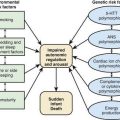Chapter 247 Cytomegalovirus
Clinical Manifestations
Immunocompromised Persons
The risk of CMV disease is increased in immunocompromised persons, with both primary and recurrent infections (Chapter 171). Illness with a primary infection includes pneumonitis (most common), hepatitis, chorioretinitis, gastrointestinal disease, or fever with leukopenia as an isolated entity or as a manifestation of generalized disease, which may be fatal. The risk is greatest in bone marrow transplant recipients and in patients with AIDS. Pneumonia, retinitis, and involvement of the central nervous system and gastrointestinal tract are usually severe and progressive. Submucosal ulcerations can occur anywhere in the gastrointestinal tract and may lead to hemorrhage and perforation. Pancreatitis and cholecystitis may also occur.
Bale JFJr. Screening newborns for congenital cytomegalovirus infection. JAMA. 2010;303(14):1425-1426.
Bonaros NE, Kocher A, Dunkler D, et al. Comparison of combined prophylaxis of cytomegalovirus hyperimmune globulin plus ganciclovir versus cytomegalovirus hyperimmune globulin alone in high-risk heart transplant recipients. Transplantation. 2004;77:890-897.
Foulon I, Naessens A, Foulon W, et al. A 10-year prospective study of sensorineural hearing loss in children with congenital cytomegalovirus infection. J Pediatr. 2008;153:84-88.
Fowler KB, Stagno S, Pass RF. Maternal immunity and prevention of congenital cytomegalovirus infection. JAMA. 2003;289:1008-1011.
Goelz R, Hihn E, Hamprecht K, et al. Effects of different CMV-heat-inactivation-methods on growth factors in human breast milk. Pediatr Res. 2009;65:458-461.
Kanengisser-Pines B, Hazan Y, Pines G, et al. High cytomegalovirus IgG avidity is a reliable indicator of past infection in patients with positive IgM detected during the first trimester of pregnancy. J Perinat Med. 2009;37:15-18.
Kimberlin DW, Lin CY, Sanchez PJ, et al. Effect of ganciclovir therapy on hearing in symptomatic congenital cytomegalovirus disease involving the central nervous system: a randomized, controlled trial. J Pediatr. 2003;143:16-25.
Lazzarotto T, Guerra B, Lanari M, et al. New advances in the diagnosis of congenital cytomegalovirus infection. J Clin Virol. 2008;41:192-197.
Nassetta L, Kimberlin D, Whitley R. Treatment of congenital cytomegalovirus infection: implications for future therapeutic strategies. J Antimicrob Chemother. 2009;63:862-867.
Nigro G, Adler SP, La Torre R, et al. Passive immunization during pregnancy for congenital cytomegalovirus infection. N Engl J Med. 2005;353:1350-1362.
Pass RF. Congenital cytomegalovirus infection: screening and treatment. J Pediatr. 2010;157(2):179-180.
Pass RF, Zhang C, Evans A, et al. Vaccine prevention of maternal cytomegalovirus infection. N Engl J Med. 2009;360:1191-1199.
Revello MG, Gerna G. Diagnosis and management of human cytomegalovirus infection in the mother, fetus, and newborn infant. Clin Microbiol Rev. 2002;15:680-715.
Ross SA, Fowler KB, Ashrith G, et al. Hearing loss in children with congenital cytomegalovirus infection born to mothers with preexisting immunity. J Pediatr. 2006;148:332-336.
Stagno S, Britt W. Cytomegalovirus. In: Remington JS, Klein JO, editors. Infectious diseases of the fetus and newborn infant. ed 6. Philadelphia: WB Saunders; 2005:739-781.
Vaudry W, Ettenger R, Jara P, et al. Valganciclovir dosing according to body surface area and renal function in pediatric solid organ transplant recipients. Am J Transplant. 2009;9:636-643.
Weller TH. The cytomegaloviruses: ubiquitous agents with protean clinical manifestations: I. N Engl J Med. 1971;285:203-214.
Weller TH. The cytomegaloviruses: ubiquitous agents with protean clinical manifestations: II. N Engl J Med. 1971;285:267-274.







